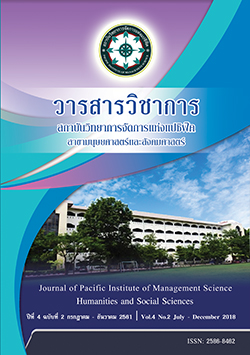Food Security Model for Households by Environmental Education Process in Pong Riverside Communiyies, Khonkaen Province
Keywords:
Food Security, Food Security Model for Households, Environmental Education Process Pong Riverside CommunitiesAbstract
The economic growth had impacts the environment therefore the households lacked the food stability. This research aimed to study the learning needs on the creation of food security for households in Phong riverside communities, Nam Phong district, KhonKaen province, develop food security model for households by environmental education process, and evaluate the appropriate of developed model. This study was a research and development. The research areas were the Pong riverside communities namely 8 sub-districts, 38 villages. The sample of this study was 350 respondents who were the representatives of households, 12 knowers, 5 experts. The data were gathered by questionnaire, group discussions and evaluation form. The data were analyzed by percentage, Item-Objective Congruence (IOC), and content analysis. The research findings were as follows: the representatives of households wanted to learning needs for creation of food security at a high level (69.07 percent). The highest need was the sustainable food self-reliant (76.60 percent), and the adequate food (70.20 percent). The food security model for households by environmental education process was the providing concepts of members for each households had a body of knowledge on the safe food, adequacy and self-reliant friendly with environment through the principles of (1) transferring body of knowledge for more potential of food production based on organic farm (2) planning households development to product and consume safe food and friendly with environment (3) connecting networks of the cooperation between households and communities (4) collaborating to keep, mitigate natural resource and environment to be safety for food production (5) use the appropriate technology and innovation with emphasized on green market to access food, having targets, creating knowledge, awareness and accurate practices in order to food self-reliant of their households. The evaluation results of model by the experts found that the model had appropriate all of items (IOC = 0.60-1.00) and could be practical.
References
เกษม จันทร์แก้ว. (2544). วิทยาศาสตร์สิ่งแวดล้อม. กรุงเทพฯ: มหาวิทยาลัยเกษตรศาสตร์.
ชล บุนนาค. (2558). แนวคิดว่าด้วยการจัดการทรัพยากรร่วม: ประสบการณ์จากต่างประเทศและแนวคิดในประเทศไทย ชุดหนังสือโครงการการสำรวจองค์ความรู้เพื่อการปฏิรูปประเทศไทย. กรุงเทพฯ: คณะทำงานเครือข่ายวิชาการเพื่อการปฏิรูป.
ธีรวุฒิ เอกะกูล.(2543). ระเบียบวิธีวิจัยทางพฤติกรรมศาสตร์และสังคมศาสตร์. อุบลราชธานี: สถาบันราชภัฏอุบลราชธานี.
พฤกษ์ ยิบมันตะสิริ และคณะ. (2553). การพัฒนาตัวชี้วัดความมั่นคงทางอาหารภายใต้ บริบทสังคมไทย จังหวัดเชียงใหม่. กรุงเทพฯ: สำนักงานคณะกรรมการสุขภาพแห่งชาติ.
มินตรา สาระรักษ์ และเสาวลักษณ์ แสนนาม.(2557). ความมั่นคงทางอาหารในครัวเรือนของประชาชนบ้านเมืองหมีน้อย ตำบลกวนวัน อำเภอเมือง จังหวัดหนองคาย. วารสารวิทยาศาสตร์และเทคโนโลยี มหาวิทยาลัยอุบลราชธานี. 16, 3: 25-37.
วิรัลพัชร ประเสริฐศักดิ์. (2558). ความมั่นคงทางอาหาร: จากพัฒนาการเกษตรสู่เศรษฐกิจพอเพียง. วารสารการเมืองการปกครอง. 5, 2: 144-160.
สมาคมพัฒนาคุณภาพสิ่งแวดล้อม. (2551).เกี่ยวกับขยะมูลฝอย. สืบค้นจาก http://www.adeq.or.th/web/new/_news_green_detail
สำนักงานทรัพยากรธรรมชาติและสิ่งแวดล้อมจังหวัดขอนแก่น. (2559). รายงานสรุปสำนักงานทรัพยากรธรรมชาติและสิ่งแวดล้อม จังหวัดขอนแก่น ประจำปี 2559. ขอนแก่น:สำนักงานทรัพยากรธรรมชาติและสิ่งแวดล้อมจังหวัดขอนแก่น.
สำนักงานพัฒนาระบบข้อมูลข่าวสารสุขภาพ.(2554). ความ (ไม่) มั่นคงทางอาหารจากโลก...ถึงไทย. สืบค้นจาก http://www.hiso.or.th/hiso/picture/reportHealth/ThaiHealth2011/thai2011_21.pdf
สุวารีย์ ศรีปูณะ. (2556). การจัดการทรัพยากรธรรมชาติและสิ่งแวดล้อม. เลย: คณะมนุษยศาสตร์และสังคมศาสตร์ มหาวิทยาลัยราชภัฏเลย.
Ed Labinowich. (1971). Environmental Education. Retrieved from http://www.oocities.org/greenmem4/mean_edu.htm
Frischknecht, R., et al. (2007).Meeting the NEEDS of European Environmental Sustainability Assessment.In proceedings from: LCA of Energy - Energy in LCA; 14th SETAC Europe Case Studies Symposium, December 3 to 4, 2007, Gothenburg.
Krejcie, R. V. & Morgan, E. W. (1970).Determining sample size for research activities. Educational and psychological measurement. 30, 607-610.
Maxwell, S. (1996). Food security: a post-modern perspective. Food policy. 21, 2: 155-170.
Downloads
Published
Issue
Section
License
บทความที่ได้รับการตีพิมพ์เป็นลิขสิทธิ์ของ สถาบันวิทยาการจัดการแห่งแปซิฟิค
ข้อความที่ปรากฏในบทความแต่ละเรื่องในวารสารวิชาการเล่มนี้เป็นความคิดเห็นส่วนตัวของผู้เขียนแต่ละท่านไม่เกี่ยวข้องกับสถาบันวิทยาการจัดการแห่งแปซิฟิค และคณาจารย์ท่านอื่นๆในสถาบันฯ แต่อย่างใด ความรับผิดชอบองค์ประกอบทั้งหมดของบทความแต่ละเรื่องเป็นของผู้เขียนแต่ละท่าน หากมีความผิดพลาดใดๆ ผู้เขียนแต่ละท่านจะรับผิดชอบบทความของตนเองแต่ผู้เดียว






